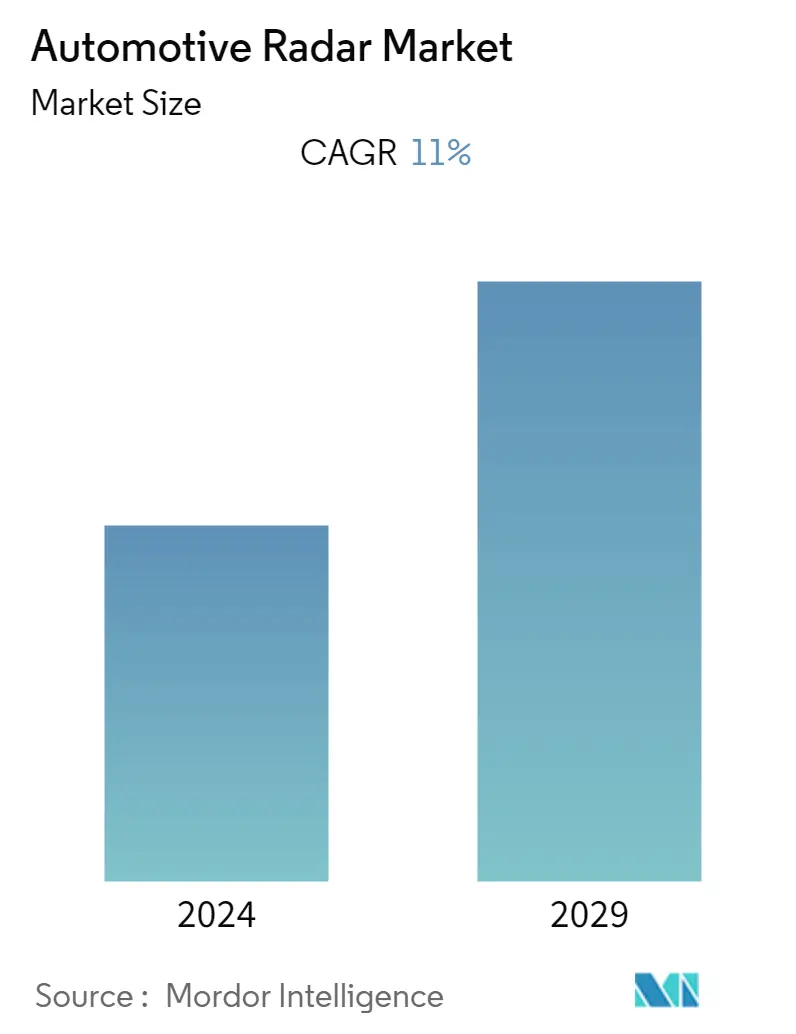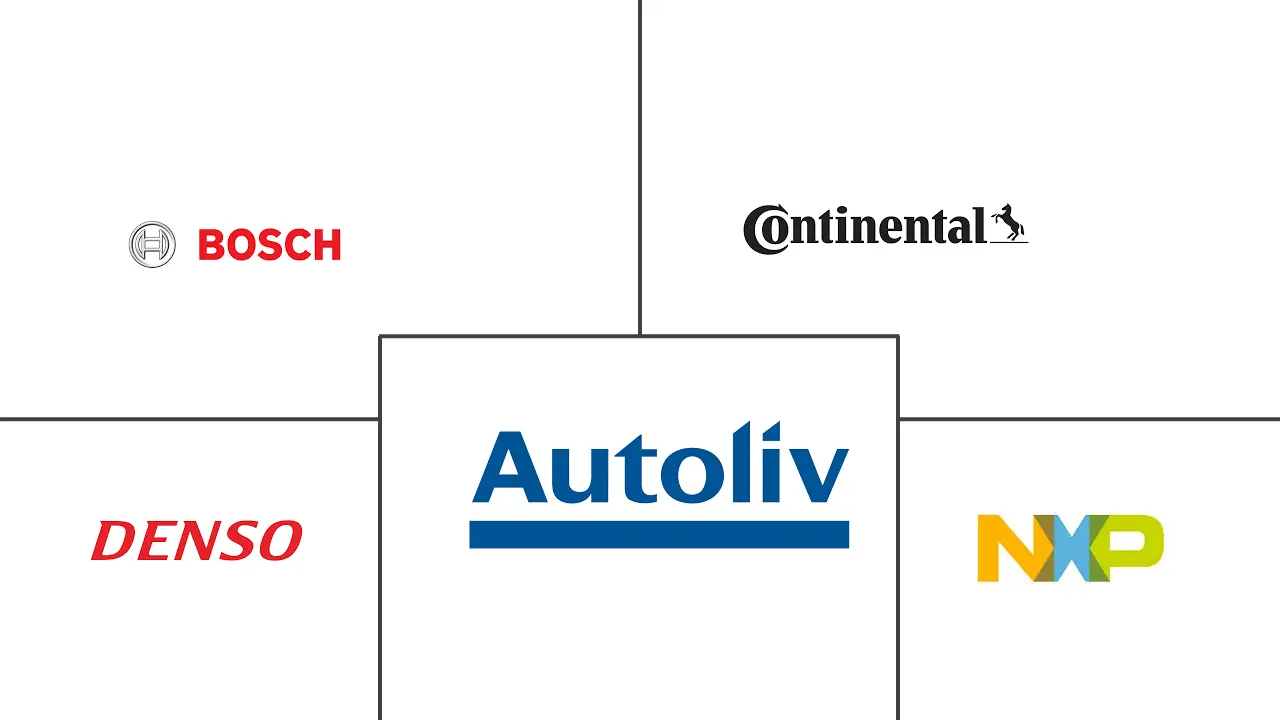Market Size of Automotive Radar Industry

| Study Period | 2019 - 2029 |
| Base Year For Estimation | 2023 |
| CAGR | 11.00 % |
| Fastest Growing Market | Asia Pacific |
| Largest Market | North America |
| Market Concentration | Medium |
Major Players
*Disclaimer: Major Players sorted in no particular order |
Automotive Radar Market Analysis
The Automotive Radar market was valued at USD 6.56 billion in 2022. It is expected to register a CAGR of 11% over the forecast period. The growth is significantly driven by the growing purchasing power of consumers leading to surging car sales, autonomous driving gaining traction, and regulatory bodies across countries mandating the inclusion of certain safety features and the adoption of advanced driver assistance systems on the rise. However, the impact of COVID-19 was severe on the automotive industry, leading to low manufacturing and sales recorded in 2020 due to the shutdown of manufacturing plans due to nationwide lockdowns and supply chain disruptions. While the early effects of the COVID-19 crisis presented a dip in the road, car sales and production are roaring back.
- Safety for drivers, passengers, and other road users has become of major interest during the last decades owing to the growing rate of road accidents globally. For instance, according to National Highway Traffic Safety Administration (NHTSA), an estimated 31785 people died in traffic crashes in the US in the first nine months of 2022. To this end, radar sensors were essential to detecting other vehicles, pedestrians, or bicyclists and the road environment. Radar is insensitive to bad light and severe weather conditions and can directly measure distance, radial velocity, and with a suitable antenna system, also the angle of remote objects.
- Moreover, government regulation in the automotive industry directly impacts the way cars look, the design of their components, the safety features incorporated, and the overall performance of any given vehicle. As a result, government regulation also significantly affects the automotive business. For instance, in October 2022, the Transport Department in India made many amendments to vehicle safety by including various vehicle safety features in two broad categories: active and passive safety. Hence, all carmakers must introduce these safety features to sell their cars in India. These factors have further promoted the role of the automotive radars market.
- For instance, in the beginning, the focus was on distance warning and crash avoidance, but with increasing maturity and complexity, functions included adaptive cruise control (ACC), automatic emergency brake (AEB), blind spot detection (BSD), or lane change assist (LCA). Nowadays, safety functions protecting passengers and vulnerable road users play a major role.
- Moreover, there is a significant rise in luxury and electric vehicle sales as, along with providing traditional comfort, convenience, entertainment, and safety features, luxury cars bristle with advanced connectivity elements, autonomous-driving options, and the latest powertrain electrification technologies. They also have some of the strongest brands in the industry. Moreover, automotive manufacturers' growing focus on seeing fleet of driverless cars efficiently delivering people to their destinations has captured and fueled billions of dollars in investment in recent years. Even after some setbacks that have been pushing out timelines for autonomous vehicle (AV) launches and delayed customer adoption, the mobility community still broadly agrees that autonomous driving (AD) has the potential to transform transportation, consumer behavior, and society at large.
Automotive Radar Industry Segmentation
The Radar (Radio Detection and Ranging) technique works on the principle of a source transmitting the radio wave, being reflected by a surface, and receiving and processing by a receiver system. One such application where RADAR is seeing an unprecedented uptake is the automotive application and, more specifically, ADAS solutions that deliver enhanced safety and comfort.
The Automotive Radar Market is segmented by Type of Product (Short-Range, Mid-Range, Long-Range), by Application (ADAS/Autonomous Driving, Occupancy Monitoring, Robotaxis Autonomous Driving), and by Geography (North America, Europe, Asia-Pacific, Rest of the World). The market sizes and forecasts are provided in terms of value (USD) for all the above segments.
| By Type of Product | |
| Short-Range | |
| Mid-Range | |
| Long Range |
| By Application | |
| ADAS/Autonomous Driving | |
| Occupancy Monitoring | |
| Robotaxis Autonomous Driving |
| Geography | |
| North America | |
| Europe | |
| Asia-Pacific | |
| Rest of the World |
Automotive Radar Market Size Summary
The Automotive Radar market is experiencing robust growth, driven by increasing consumer purchasing power, the rise of autonomous driving, and regulatory mandates for enhanced safety features and advanced driver assistance systems (ADAS). The market's expansion is further supported by the growing emphasis on road safety, as radar technology plays a crucial role in detecting vehicles, pedestrians, and other road users, even in adverse weather conditions. The automotive industry is witnessing a significant shift towards luxury and electric vehicles, which are equipped with advanced connectivity, autonomous driving options, and powertrain electrification technologies. This shift is fueled by substantial investments in autonomous vehicle technology, despite some delays in timelines for launches and customer adoption. The integration of radar technology in ADAS applications, such as object detection and collision mitigation, is becoming increasingly important as vehicle digitization and electrification continue to rise.
The Asia-Pacific region holds a significant share of the Automotive Radar market, driven by increasing vehicle sales and a surge in demand for electric vehicles. The presence of major manufacturing industries in countries like China, India, and Japan contributes to the market's growth, with developing economies experiencing faster automotive production growth. Consumers in these regions are increasingly opting for vehicles with advanced features, further propelling market expansion. The competitive landscape of the Automotive Radar market is marked by the presence of established players and new entrants leveraging advancements in chip design. Recent developments, such as Renesas Electronics Corporation's entry into the market and the launch of innovative radar technologies by companies like Rohde & Schwarz and Arbe Robotics Limited, highlight the ongoing advancements and strategic partnerships shaping the industry's future.
Automotive Radar Market Size - Table of Contents
-
1. MARKET INSIGHTS
-
1.1 Market Overview
-
1.2 Technological Evolution of Radar (Conventional Vs 4D Vs Imaging)
-
1.3 Industry Attractiveness - Porter's Five Forces Analysis
-
1.3.1 Bargaining Power of Buyers/Consumers
-
1.3.2 Bargaining Power of Suppliers
-
1.3.3 Threat of New Entrants
-
1.3.4 Threat of Substitute Products
-
1.3.5 Intensity of Competitive Rivalry
-
-
1.4 Value Chain / Supply Chain Analysis
-
1.5 An Assessment of the impact of Macro Trends (post-COVID-19, economic uncertainties, supply chain issues etc.) on the Industry
-
-
2. MARKET SEGMENTATION
-
2.1 By Type of Product
-
2.1.1 Short-Range
-
2.1.2 Mid-Range
-
2.1.3 Long Range
-
-
2.2 By Application
-
2.2.1 ADAS/Autonomous Driving
-
2.2.2 Occupancy Monitoring
-
2.2.3 Robotaxis Autonomous Driving
-
-
2.3 Geography
-
2.3.1 North America
-
2.3.2 Europe
-
2.3.3 Asia-Pacific
-
2.3.4 Rest of the World
-
-
Automotive Radar Market Size FAQs
What is the current Automotive Radar Market size?
The Automotive Radar Market is projected to register a CAGR of 11% during the forecast period (2024-2029)
Who are the key players in Automotive Radar Market?
Robert Bosch GmBH, Continental AG, Denso Corporation, Autoliv and NXP Semiconductors are the major companies operating in the Automotive Radar Market.

